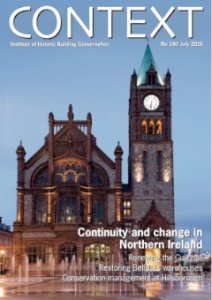 The latest issue of the IHBC’s journal Context has been circulated to members, and with so much change underway to its buildings, institutions and philosophies Context finds it opportune to look at Northern Ireland.
The latest issue of the IHBC’s journal Context has been circulated to members, and with so much change underway to its buildings, institutions and philosophies Context finds it opportune to look at Northern Ireland.
Fiona Newton writes:
Andrew McClelland guest commissioning editor for this edition said, ‘The diverse range of subject matters covered by the eight authors speaks to the complex challenges involved in conserving and adapting the old to meet contemporary needs and expectations. The necessity to positively manage change relates in part to the legislative and institutional structures governing conservation, and the governance environment shifted markedly in Northern Ireland in 2015 following local government reform.’
There has been a reduction in council numbers and many functions critical to conservation, such as land-use planning, have been devolved to the local level for the first time since the early 1970s. In essence, local authorities now possess a range of meaningful powers in relation to the management of the local historic environment, essentially mirroring those long held by their counterparts in Great Britain.
The first two authors, Manus Deery and Bronagh Lynch, address local government reform from two different perspectives. Deery outlines the changing role and functions of both local and central government as the new institutional landscape takes shape in Northern Ireland. Lynch discusses the history and refurbishment of the Guildhall in Derry-Londonderry, from the point of view of the conservation practice working on the scheme. The Guildhall now represents a fitting symbol for this new era of local government in the city and north-west region.
The important work of building preservation trusts (BPTs) in Northern Ireland is the focus for articles by James Moir and Primrose Wilson. With evidence emanating from a forthcoming report, Moir offers a timely strategic overview of local trust activity, while setting out both the challenges and new opportunities for the continued development of their valuable work. The can-do attitude so often demonstrated by BPTs is illuminated further by Wilson, who articulates the struggles and ultimate triumphs of the Follies Trust as it seeks to conserve a diverse range of ‘joyful little buildings which aim to please’.
The continued efforts to save Belfast’s industrial heritage feature prominently in the articles by Paul Mullan and Marcus Patton. The shipbuilding and linen industries were critical to the growth of the city in the 19th century but, as elsewhere on these islands, economic change inexorably led to the abandonment and demolition of many of the physical remnants of that era. However, as Mullan outlines, the funding possibilities on offer are enabling the reuse of industrial complexes like the former Harland and Wolff headquarters building and drawing rooms. Furthermore, the proposed reuse of another former industrial building in the city centre of Belfast is referenced by Patton, who provides a fascinating insight into warehouse architecture. Although essentially utilitarian, the warehouses constructed by the Victorians and Edwardians in Belfast were exuberantly detailed.
The management of one of Northern Ireland’s most well-known historic buildings, Hillsborough Castle, County Down, is the subject of Christopher Warleigh-Lack’s article, in which he discusses Historic Royal Palaces’ (HRP) new role as custodian. As with all good conservation projects, the conservation management plan drawn up by HRP has been fundamental to forming a clear understanding of the historical development of the building and its surrounding demesne.
Máiréad Nic Craith and Ullrich Kockel explore what they term the ‘yin and yang’ of heritage. Their article sets out the challenge for historic environment professionals to fully embrace in their thinking both the tangible and intangible qualities of the built environment. As Craith and Kockel assert, the further development of traditional building skills represents one means of progressing a more holistic approach to heritage that is cognisant of intangible values.
If you have any suggestions for articles or other material contact Fiona Newton at: editorial@ihbc.org.uk
Explore IHBC Context online archive
For information on Context’s future issues, guidance for authors, and links to the journal’s archives see the IHBC website
